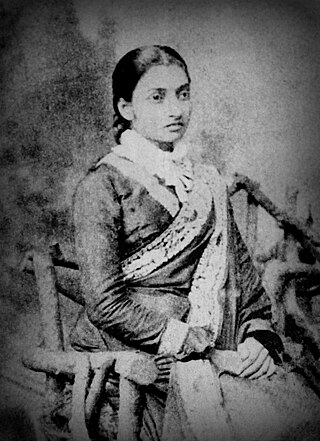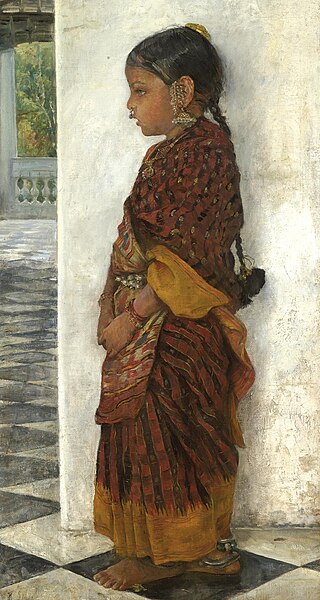Related Research Articles

A sari is a women's garment from the Indian subcontinent. It consists of an un-stitched stretch of woven fabric arranged over the body as a robe, with one end attached to the waist, while the other end rests over one shoulder as a stole, sometimes baring a part of the midriff. It may vary from 4.1 to 8.2 metres in length, and 60 to 120 centimetres in breadth, and is a form of ethnic wear in India, Sri Lanka, Nepal, Bangladesh, and Pakistan. There are various names and styles of sari manufacture and draping, the most common being the Nivi style. The sari is worn with a fitted bodice also called a choli and a petticoat called ghagra, parkar, or ul-pavadai. It remains fashionable in the Indian subcontinent today.
Devanga is a Hindu caste from South India that traditionally followed the occupation of textile merchandise, weaving and farming mostly found in the Indian states of Karnataka, Kerala, Andhra Pradesh, Tamil Nadu and Odisha.
Balaramapuram is one of the panchayats that form the city of Thiruvananthapuram, the capital of Kerala, India. It is the most urbanized panchayat in Thiruvananthapuram.
Ilkal is a City in Bagalkot district in the Indian state of Karnataka. The town is located in a valley that lies in south-east corner of Bagalkot district and is quite close to the borders of Kushtagi taluk of the Koppal district. Now Ilkal city becomes taluk previous the city falls within the jurisdiction of Hungund taluk and lies at a distance of about 12 km (7.5 mi) south of taluk headquarters. Between these two towns, Ilkal is an important centre of trade, commerce, education, and industry. Ilkal is well connected with state and national highways. It is also famous for its hospitality and education institutions.

Kerala sari (Set-sari) is a clothing of women in the Indian state of Kerala.

Baluchari Sari is a type of sari, a garment worn by women in the Indian states of West Bengal, Tripura and Assam and the country of Bangladesh. This particular type of sari originated in West Bengal and is known for depictions of mythological scenes on the anchal of the sari. It used to be produced in Murshidabad but presently Bishnupur and its surrounding areas of West Bengal are the only place where authentic Baluchari saris are produced. It takes approximately one week to produce one such sari. In 2011, the Baluchari Sari was granted the status of Geographical Indication for West Bengal in India.

Pochampally sari or Pochampalli ikat is a saree made in Bhoodan Pochampally, Yadadri Bhuvanagiri district, Telangana State, India. They have traditional geometric patterns in "Paagadu Bandhu" (Ikat) style of dyeing. The intricate geometric designs find their way into sarees and dress materials. The Indian government's official airplane company, Air India, has its cabin crew wear specially designed Pochampally silk sarees.

Gajam Anjaiah, an Indian master handloom designer, who is widely recognised in the handloom industry for his innovations and developments of Tie and Dye handloom products along with Telia Rumal technique of weaving based on Ikat tie-dye process. He received Padma Shri from Government of India under Art category in 2013. He is known for his excellence in traditional handloom design works, such as Puttapaka Sarees in Tie and dye skill, that is the traditional art of designing on paper and then transferring it on to cloth. His dedication to the Handloom Industry has kept the Indian tradition of weaving alive, brought livelihood to the weavers and gave exclusive/unique designed handloom products to the people in India.
Puttapaka Saree is a saree made in Puttapaka village, Samsthan Narayanpuram mandal in Nalgonda district, India. It is known for its unique Puttapaka tie and dye style of sarees.
Kovai Cora cotton or Kovai Kora cotton is a type of cotton saree made in the Coimbatore region in Tamil Nadu, India. It has been recognized as a Geographical indication by the Government of India in 2014–15.

Handloom saris are a traditional textile art of Bangladesh and India. The production of handloom saris is important for economic development in rural India.
Padmanabhan Gopinathan is an Indian master weaver of handloom textiles and the founder of Eco Tex Handloom Consortium, an organization promoting handloom weaving in Manjavilakom, a small hamlet in Thiruvananthapuram, in the south Indian state of Kerala. Under the aegis of the organization, he provides employment to over 1800 women in the village. The Government of India awarded him the fourth highest civilian honour of the Padma Shri, in 2007, for his social commitment and his contributions to the art of weaving.
Kuthampally dhoties and set mundu are dhoties and set mundus manufactured by the weavers in the Kuthampally region in Kerala, India. This clothing product has been registered under Sub-section (1) of Section 13 of the Geographical Indications of Goods Act, 1999 with effect from 13 November 2015. The registration was recorded as per an application made by Kuthampully Handlom Cluster Charitable Society Consortium.

Habaspuri is a cotton-based traditional handloom textiles of Odisha, India. Habaspuri sari is a major product of this textile. The Bhulia weavers of Chicheguda, Kalahandi district, Odisha are originally attributed for weaving of the Habaspuri fabric. For its uniqueness in weaving, design and production, it has been identified as one of the 14 Geographical Indications of Odisha.
Kotpad Handloom is a vegetable-dyed fabric woven by the tribal weavers of the Mirgan community of Kotpad village in Koraput district, Odisha, India. Cotton sarees with solid border and Pata Anchal, duppatta with typical Buties / motifs, Scolrfs on cotton, silk, handloom stoles, and dress materials are all dyed with organic dyes. The natural dye is manufactured from the aul tree grown in this area. The Kotpad tussar silk saree with tribal art and Kotpad handloom fabrics with natural color is its specialty.
The handloom industry in Tangail is one of the oldest cottage industries in Bangladesh. This traditional saree is produced in Tangail district and is named after the place.
Gobardhan Panika is an Indian master weaver of Kotpad handloom a traditional tribal craft. The Government of India awarded him the fourth highest civilian honour of the Padma Shri, in 2018, for his contributions to the art of weaving.
Kasavu is a technique used in handlooms of Kerala, with very fine threads of gold or silver used in weave to make border lines and designs on silk and cotton fabrics. This technique later spread to most of India and the Kasav technique was developed for many other fabrics across India. White or off-white cotton cloth with Kasav borders that originated in the South Indian state of Kerala is now famous as Kerala saree is believed to be first form of use of Kasav technique.

Chendamangalam Saree is a traditional hand woven cotton sari from Chendamangalam, Ernakulam district of Kerala. This saree is part of the Chendamangalam Handloom tradition of Kerala.
Biren Kumar Basak is an Indian handloom weaver from the Nadia district. He is the recipient of Padma Shri, the fourth highest civilian award of India.
References
- ↑ "Kuthampully Saree". external. Archived from the original on 11 April 2021. Retrieved 3 October 2019.
- ↑ "Kuthampully sarees get an IP address, weave history". The Times of India . Archived from the original on 3 January 2013. Retrieved 13 June 2012.
- ↑ "Kerala handloom to get international branding". The Times of India . Archived from the original on 3 January 2013. Retrieved 13 June 2012.
- ↑ "Kuthampully". Thiruvilwamala. Retrieved 13 June 2012.
- ↑ "Weaving a Devanga style". Keralalivenews. Retrieved 13 June 2012.
- ↑ "Kuthampully Kerala Saree".